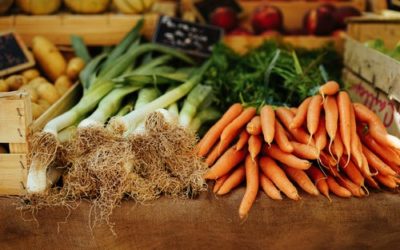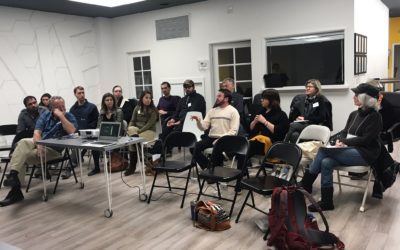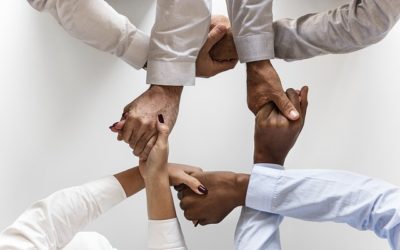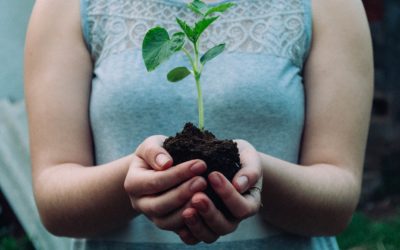By Stephanie Oelsligle Jordan, Local Food Program Manager
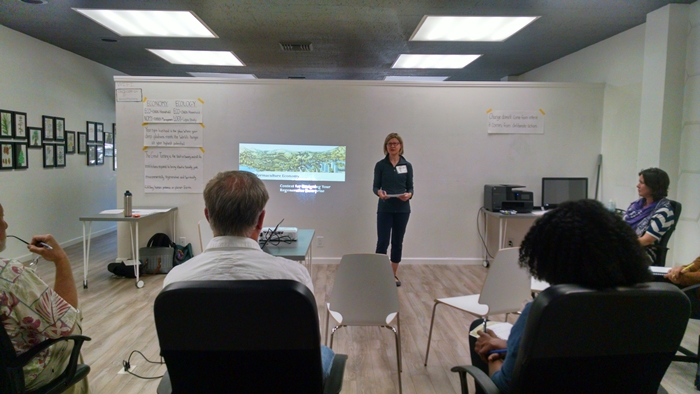
Local Food Program Manager Stephanie Oelsligle Jordan presents what she learned at the workshop to community members.
Between January and April, Santa Cruz Permaculture presented a series of four workshops entitled “Systems Change & the Next Economy: Regenerative Design for People & the Planet.” The series featured instructors with diverse backgrounds who are critically examining aspects of our economic, financial and monetary systems, as well as offering alternative models, inspiring examples and ideas for a new economic system that works for everyone.
My fellow Sustainable Solano co-workers had gone before me to the first three workshops, and on April 6 and 7, it was my turn. Led by Erin Axelrod and Kevin Bayuk of LIFT Economy, over the weekend we would “collectively explore the possibility of how we can redesign the economy to create regenerative outcomes of security, prosperity and a stable climate rather than outcomes of exploitation and inequity. By gaining an understanding of the design constraints of the ‘business as usual’ economy we will chart a pathway of transformation, using permaculture design principles, methods and ethics, to an economy that works for the benefit of all life. We will explore how to design enterprises and organizations that provide needed goods and services in ways that enhance and restore environmental and social prosperity.”
A tall order, but my group of around seven workshop participants jumped in with enthusiasm and curiosity.
We began by looking at the current problems: How currency use and certain economic activities have catalyzed a culture where humans don’t need anyone else — we only need money. (Or at least we think we don’t need anyone else.) This has resulted in lack of trust in people, only trust in money, and a laundry list of negative economic patterns (endless economic growth, greed, competition, prioritization of profit, commercialization, etc.) and skewed beliefs (“If I don’t have a leg up with inherited wealth, I’m not going to make it!”; “If you’re wealthy, that’s proof that you deserve more money!”; “If there’s a top category of wealthy people, there must be a bottom category”).
Erin pointed out that capitalism, as a system, has been good at suppressing alternatives and perpetuating itself, and making losers in the game. One point that I found fascinating was how humans are the only species with the concept of “unemployment,” and the idea that they/we have nothing to contribute. (Indeed, the squirrels scurrying around my backyard have endless work to do, within their functioning, natural ecosystem!)
So, now what?
Erin and Kevin argued that it is time to re-focus and think about how choices around business design and structure matter. What are models of creating businesses/organizations that don’t require passing on expenses to the end user? How can we find ways to meet our needs based on connection/community, and less on transaction/extraction? How can we design enterprises and organizations that provide needed goods and services in ways that enhance and restore environmental and social prosperity? Permaculture principles, which focus on “Earth Care, People Care and Fair Share,” provide the guiding star for this work. Is there a way to create an economy that works for the benefit of all life?
There are more questions than answers, but to try and arrive at some answers, Erin presented an interesting diagram:

Where we are now is at the top of the top curve, where the dotted line connects. “Business as usual” is the dotted line, which represents endless economic growth — but at the expense of others. The Hospice line represents activities that help the current system (with its inequities) to die off. The Midwifery line represents bringing in entirely new economic principles. And if all goes according to plan, we have a more equitable “Next Economy.”
There are lots of questions/issues around this graphic. Midwifery requires resources, which some organizations don’t have. Sometimes “hospice” is just keeping the bad from getting worse, and not actually working to stop dysfunctionality in the system. We then tried brainstorming examples of organizations that are practicing either “hospice” or “midwifery.” Patagonia would be one such example, as they are interested in repairing your (expensive) clothing, and not replacing it. They are trying to “hospice out” the “throw-away mentality” among consumers in the clothing industry and at the same time, “midwife” the idea of investing in fewer, higher-quality garments created in a fair trade system.
Another example that came up was TerraCycle. TerraCycle offers free recycling programs funded by brands, manufacturers and retailers around the world to help collect and recycle hard-to-recycle waste. But what I realized was that for TerraCycle to be completely effective, they need to be willing to go out of business. Some businesses that claim/work for good need to be so effective that they wouldn’t need to exist anymore.
We do have some organizations and people trying to do the right thing. But, when organizations/businesses are interfacing with the economy and trying to do the right thing, they hit a snag. Erin and Kevin call it the “Price Parity Paradox.” This means that when you are implementing a good/service and doing it “right” (equitable, environmentally sustainable, etc.), you end up with higher prices, making the thing inaccessible to those who might need it most. For example, let’s say I’m a community kitchen sourcing from small to mid-sized local farms (who practice sustainable agriculture) and paying fair prices for the ingredients. I’m also paying my staff – everyone from the dishwashers to the sous chefs – fair wages to produce nutrient-dense food. However, to maintain this business and be sustainable, my pricing needs to be at a certain level, which can only be afforded by wealthier people in the community. My products are too expensive and not accessible to certain populations who might need my nutrient-dense food the most (i.e. low income customers with health challenges).
All hope is not lost, however. Erin and Kevin presented some possible solutions to the Price Parity Paradox:
On the Demand Side:
- Make Customers Your Owners (Cooperatives)
- Differentiate Pricing (sliding scales, free vs. premium, even “pay what you can … or what you think it’s worth”)
- Transparency (being really honest with your customers about what it costs to grow the food, make the soup, etc.)
This brought up more questions around perception of value: How do we get that shift where people are investing in things that benefit all life? Where are the people who are voluntarily ethical, and how did they get that perspective? How did they form value around certain things? Who are these self-selecting individuals opting in to pay more?
On the Supply Side:
- Partially or Totally Vertically Integrate (not so much to remove the middle man, but to remove the middle margin)
- Vertically Integrate Through Local Joint Ventures (Who in my community could be as invested as me in growing the business? An example was a roof builder who partners with a gutter repair person.)
- Reducing Salary Expense Through Creative Total Compensation (flexible hours, a CSA box, 401(k) that feeds back to the community)
- Worker-Ownership (good for weathering recessions)
- Innovation (renting out goods during off-season; selling viable by-products; communicating the durability of goods, detracting from the “throw-away” mentality)
Very few organizations are doing ALL supply and demand solutions to solve the Price Parity Paradox, but many are trying. It’s difficult because we are still operating within the constraints of the “business as usual” system. But let’s say you have an idea for an organization or business.
Here’s the theory: to get to that Next Economy place on the chart,
you’ll need to follow 10 Principles:
- Need-Oriented, Basic Goods and Services. Stick with the basics. How many businesses do we really need? Some are there simply to fulfill the “shiny object syndrome!” Our culture shapes our definition of need. How is our culture a product of something greater that needs shifting?
- Diverse & Inclusive Ownership. The more diverse the team, the better it comes up with solutions and there’s more creativity. When you prepare to work with others, you put more work into it. More diverse groups bond around VALUES, not race/gender/age, etc. When you design for the most vulnerable population, it benefits everyone. But there must be ownership, otherwise it’s tokenism.
- Equitable/Democratic Culture. An example of this would be multi-stakeholder cooperatives. (An example you can look up is “Our Table,” a cooperative of farmers/producers, worker-owners and consumers.) Democratic culture could be an organizational method/structure called “holocracy,” which is practiced by Three Stone Hearth in Berkeley.
- Support of the Local Economy Ecosystem. How is the organization banking? At a large bank that engages in the extractive economy, or with a credit union or smaller progressive bank? An example that came up was Beneficial State Bank, which has its assets owned by a nonprofit. Another example to consider are B Corps: corporate entities that are beholden not only to profit, but also to stakeholders and the environment, and are assessed by third parties on ownership, culture, environment, etc.
- Embed Education Into the Good or Service. This looks at “known needs” vs. “unknown needs.” Look within existing markets to educate, instead of creating something new. Education often benefits businesses and hopefully will catalyze a cultural shift, because the value of the product is understood. And we can probably all agree that culture change happens before policy change!
- Open Source. No monetary exchange for information (the idea of ownership and property emerge out of a “scarcity” mindset). What’s the benefit of a software company doing open source? Maybe someone will improve the code after putting it out there. However, the tension is that something will be taken, used (and perhaps commodified) by the extractive economy.
- Transparency. Everyone who participates in the business will make better decisions if they know more about finances, governance, etc. On the consumer side, it’s also education: You can give a breakdown of where the money goes to make the jacket, the food, etc. Another example is Participatory Budgeting (as done in Vallejo).
- Zero Waste & Climate Beneficial. Look at the system, and strive to create symbiotic relationships. For example, when farmers enrich their soil, they get not only more nutrient-dense food, but land that helps pull more carbon out of the atmosphere. Farms that have a commercial kitchen on-site so that food scraps can be composted back into the land are another example.
- Scale by Regional Replication. Don’t scale up — scale across. If you scale up (which “business as usual” does), then the problem of endless economic growth in a world with finite resources continues. Sometimes this is place-specific, to be adapted to different environments, soil, watersheds, etc.
- Supportive of Personal Growth & Development. This is a workplace that can produce/provide needed goods/services AND provide personal growth and development of the people who work there. What needs to get done on a personal level to support transition? How can we get rid of the scarcity mindset? How can we put our population/community/workers at the core of the designing of a resilient system?
In our quest to design the Next Economy, we have circled back to the personal level. Here is another graphic that ties in personal purpose with an economic system:

As we wound down the weekend, I was reminded of the quote that Erin shared with us at the beginning of the weekend. It is from Adrienne Maree Brown, author of “Emergent Strategy: Shaping Change, Changing Worlds”:
Do you already know that your existence – who and how you are – is in and of itself a contribution to the people and place around you? Not after or because you do some particular thing, but simply the miracle of your life. And that the people around you, and the place(s), have contributions as well? Do you understand that your quality of life and your survival are tied to how authentic and generous the connections are between you and the people and place you live with and in?
⠀⠀⠀⠀⠀⠀⠀⠀⠀⠀⠀⠀⠀⠀⠀⠀⠀⠀⠀⠀⠀⠀
Are you actively practicing generosity and vulnerability in order to make the connections between you and others clear, open, available, durable? Generosity here means giving of what you have without strings or expectations attached. Vulnerability means showing your needs.
Changing a system is big work that requires years of travel down a long, long road. But by attempting to integrate some of these concepts into our lives, businesses and organizations, perhaps we can start to shift our culture. Perhaps we can have positive effects on other systems which are inextricably linked to our economic system, and perhaps someday we will be living within the “Next Economy.” Good luck!
The funding for Sustainable Solano’s team training at the “Next Economy” course at Santa Cruz Permaculture was provided by Solano Community Foundation through their NPP Capacity Building grants program. Community conversations are made possible through a grant from the Peaceful World Foundation. Thank you to both organizations!
Creating Change During a Crisis
When there is a crisis, it often can reveal underlying flaws in the existing system as well as opportunities for change. The current economic crises brought on by the COVID-19 pandemic also opens the dialogue for how to shift our economy in a way that works for more people.
Next Economy: Making Sense of Our Banking System
This discussion shared insights into why the current financial system is going the way it is and how we might begin to alter that course.
Next Economy: Exploring the Role of Community and Restorative Economics
“Change doesn’t come from intent. It comes from deliberate action.” – Nwamaka Agbo
Caretaking of Nature and Community: A Conversation Between Wendell Berry and Helena Norberg-Hodge
Two local economy advocates explore caring for local communities and the environment.

